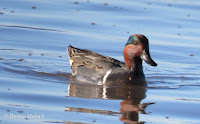GENERAL INFORMATION ON BIRDS
Birds are fascinating animals, not the least because they can fly. Flying is a feat that humans have striven for and finally succeeded at after many long centuries of trials and disasters. Birds are descendants of dinosaurs just as crocodiles and turtles are.
Birds come in very different sizes and sometimes striking colors, and some are even flightless. Some are social, others not. Some are predators, others are preyed upon. The bill shape determines the diet – conical for seed eaters for example.
Some bird species are sedentary, while others are migratory, and among the latter the record holder is the arctic tern with an annual migration distance of some 80,000 km (50,000 mi.) from one pole to the other and back. Birds face all kinds of dangers during their migrating flights – one can be ‘headwinds’ that push them back in the opposite direction.
Birds vocalizations – or ‘language’ – are studied on an ongoing basis. When a large group of American crows gathers at sunset at the top of trees and are all calling at the same time, or when an American robin sings an early morning happy tune from a high perched position, or when males display species-specific elaborate courtship rituals – those are fascinating examples of birds communicating.
 |
| Green-winged teal, winter visitor to Hawaii |
The color of the plumage will also change for some species depending on the season, also whether it’s a male or female, a mature individual or juvenile. Sometimes the same bird will have a different plumage depending on the country (for example the Great Cormorant) where it is found.
Usually we think of ‘evolution’ in terms of very long periods of time, i.e. millions of years. Actually, scientists are sometimes able to watch evolution unfold before their eyes, so to speak. For example, they were able to observe a type of predator grow a larger bill to catch a species of snail much larger than their usual prey. City environments can also trigger new evolutionary traits, such as larger bills in finches that feed from backyard feeders.
WHAT’S IN A NAME? For most bird species on this website, an explanation is being provided for the rationale behind a bird name, either English or Latin. For more information on this interesting aspect of a bird’s identity, please check this page of the ornithologist Roger Lederer’s website: http://ornithology.com/names/